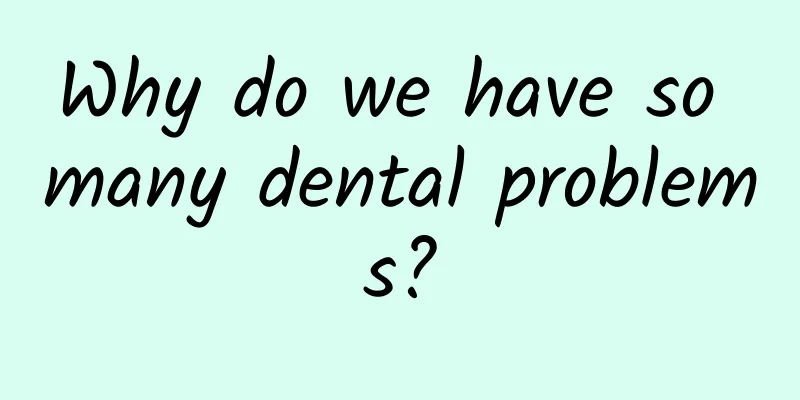Why do we have so many dental problems?

|
Leviathan Press: If you look around at the people around you, you may find that it seems that there are very few people who have no problems with their teeth, and those who have problems are different: wisdom teeth, caries, tooth deformities... If compared with other vertebrates, our dental problems are more prominent. The author of this article believes that this situation actually appeared very late - people in the industrial age began to have a large number of dental problems, which can be attributed to changes in dietary structure. In other words, the evolution of teeth cannot keep up with the brain, so they are not adapted to the modern dietary structure, resulting in many problems. This reminds me of another saying: humans often have backaches because their body structure is not yet adapted to walking upright. I don’t know if it’s true or not. I sat outside the dental office waiting for my daughter. The scene was like an assembly line: patients came in one after another, asking to have the third molars, which we usually call wisdom teeth, removed, and then they came out with bandages wrapped around their heads, tied in a way that was suitable for ice packs. Everyone held a T-shirt given by the doctor, a home care manual that had been printed long ago, and prescriptions for antibiotics and painkillers. Today, wisdom teeth removal has become almost a tradition in the United States. But from my perspective, this "tradition" is not that old. I am a dental anthropologist and evolutionary biologist, and I have spent 30 years studying the teeth of contemporary humans and fossil humans and countless other species. The dental problems we see today are not normal. Not only do most other vertebrates not have the same dental problems we do—they rarely have crooked teeth or cavities—but even our fossil ancestors had no wisdom teeth to interfere with their lives and almost no gum disease. Indeed, modern human teeth are a paradox: they are the hardest part of our body, yet they are very fragile. Although ancient human teeth can survive millions of years in fossils, our teeth do not seem to last a lifetime in our mouths. Teeth allowed our ancestors to dominate the organic world, but today, our teeth require special daily care. These inconsistencies are recent, that is, they only occur in the contemporary population of the industrial age. The best explanation is that today's diet is not compatible with the teeth and jaws we have evolved over time. Paleontologists have long known that our teeth are rooted in evolutionary history, and now clinical researchers and dentists are beginning to pay attention to this fact. Ancient Origins Evolutionary biologists often lament that the human eye is a "miracle of design" by nature. But to me, eyes are a less important evolutionary achievement than teeth. Our teeth are used to grind food without damaging ourselves, and we chew millions of times throughout our lives. Amazingly, our teeth are made of the same ingredients as the food we chew. Engineers can learn a lot from the structure of human teeth. The remarkable strength of human teeth comes from an elaborate structure that gives them the hardness and toughness to resist the appearance and propagation of cracks. The combination of these two properties is a combination of two components: the hard outer covering of enamel, which is made almost entirely of calcium phosphate, and the inner layer of dentin, which also has organic fibers that give the tissue its elasticity. The real magic of our teeth, though, is actually on a microscopic scale. Imagine that dried spaghetti would break at the slightest bend. But what if there were thousands of strands of spaghetti-like strands? The enamel structures on the surface of our teeth, called crystallites, are like tens of thousands of strands, each one only one-thousandth the thickness of a human hair. They are bundled together to form rods of enamel, called prisms. These prisms are simply bound together at a density of tens of thousands per square millimeter to form tooth enamel. They run parallel to each other, from the surface of the tooth to the dentin inside, wriggling, weaving and twisting as they move, a structure that is not only elegant but also impressively durable. This design did not emerge overnight. Nature has spent hundreds of millions of years updating animal teeth. Recent insights from paleontology, genetics and developmental biology have allowed researchers to reconstruct the evolution of animal tooth structure. The first vertebrates were jawless fish that appeared more than 500 million years ago during the Cambrian period. These earliest fish had no teeth, but many of their descendants had scale-like tails and heads made of scale-like calcium phosphate. Each scale had an outer surface of dentin, sometimes covered by a harder, more mineralized cap, and an inner pulp cavity that housed blood vessels and nerves. The mouths of some fish are surrounded by a rim of small nubs or barbs on a plate that may have aided in feeding. Most paleontologists believe that these scales eventually evolved into teeth. In fact, the scales of today's sharks are so similar to teeth that we group them together, called odontodes. Developmental biologists have shown that shark scales and teeth develop in the same way as embryos, and recent molecular evidence confirms that they are controlled by the same set of genes. Then there are the true teeth, the jaw-like ones. Most of these teeth are simple pointed structures that can be used to capture and hold prey, as well as scrape, pry, grab and clamp various organisms. For example, some Acanthodii (extinct spiny fish related to ancestral sharks) had teeth during the Silurian period, about 430 million years ago. They didn't have the hypermineralized cap covering the crown of dentin, which was neither shed nor replaced, but they were still teeth. Some species' lip and cheek scales gradually turned into teeth, and this evolutionary process continued. Even the earliest teeth quickly made the species with teeth stand out and gave them an advantage in the primitive oceans. This also made teeth popular in the oceans, because the species with teeth quickly became dominant. Once teeth became standard equipment for animals, many innovations and modifications followed—including changes in shape, number and distribution, how teeth are replaced and how they are fixed to the jaw. Tooth enamel first appeared in the sarcopterygian group of bony fish, at the turn of the Silurian and Devonian periods, about 415 million years ago. Both sarcopterygians and modern tetrapods—whether amphibians, reptiles or mammals—are directly related to these fish. Sarcopterygii are known for their paired front and back fins, with bones and muscles similar to limbs. But other fish of the time had teeth that lacked enamel. The enamel was originally limited to scales, suggesting that enamel, like teeth, originated in skin structures and then evolved into the mouth. Teeth played a pivotal role in the origin and early evolution of mammals because they play a major role in helping mammals maintain their body temperature. The ability of animals to generate their own body heat has many advantages, such as enabling these species to live in cool climates and places with large temperature differences; allowing these species to maintain high movement speeds to maintain larger territories; and providing endurance for foraging, avoiding predators, and caring for offspring. But homeothermy also comes with a cost: mammals use 10 times more energy when at rest than reptiles of similar size. Maintaining a constant body temperature requires more and more efficient absorption of heat from food, and this puts pressure on teeth. Other vertebrates only use their teeth to capture and kill prey, but mammals' teeth must provide the body with more calories per bite, and to do this, they must chew. Mammalian teeth guide chewing movements, distribute chewing forces, and hold, maintain, and crush food. For teeth to work properly during chewing, their opposing surfaces must be aligned within a fraction of a millimeter. The need for such precision explains why—unlike fish and reptiles—most mammals do not repeatedly grow new teeth throughout their lives to replace those that have been worn or broken—because their ancestors lost this ability. Prismatic enamel is part of the evolution of mammalian teeth. Most researchers believe that this evolution increased the strength of teeth to the level required for mammals to chew. Whether this prismatic enamel evolved once or more than once is a matter of debate. In any case, the basic mammalian tooth structure (prism-like enamel that forms a dentin cap) was already common by the Triassic period. The various forms of mammalian molars, including our own, are just fine-tuning of this basic structure. Built to last: Human teeth, like those of other mammals, are incredibly strong thanks to their combination of hard enamel and tough, yet soft dentin. From a microscopic perspective, the hard outer covering of enamel is made almost entirely of calcium phosphate, while the fine, dense enamel prisms that make up our enamel make up much of the toughness of dentin, which comes from the fibrous structure that makes it up. © AXS Biomedical Animation StudioMicrobial imbalance in the oral environment The evolutionary history of our teeth not only explains why they are so strong, but also why they are inadequate in modern times. The basic logic is that the evolutionary outcome of tooth structure is only useful under certain environmental conditions. In the case of our teeth, they evolved to cope with the chemicals and bacteria in our mouths, as well as the wear and tear on our teeth themselves. Therefore, rapid changes in our oral environment can catch our teeth off guard. However, our modern eating habits are very different from those of our ancestors, and they were never used by our ancestors. Our teeth are not able to cope with this change, which explains caries (cavities), wisdom teeth, and other orthodontic problems that plague us. Tooth decay is the most common and widespread chronic disease in the world. It afflicts 90% of Americans and billions of people worldwide. Yet in the past 30 years, I have studied the teeth of thousands of fossil and living animals and have seen almost no cavities. To understand why modern teeth are so susceptible to decay, we need to consider the natural oral environment. The healthy human mouth is filled with a variety of organisms, with more than 700 species and billions of them. Most of them are beneficial, fighting disease, aiding digestion and regulating various body functions. But a small number of bacteria are harmful to teeth, such as Streptococcus mutans and Lactobacillus, which attack tooth enamel with lactic acid produced during metabolism. However, these bacteria are usually not present in high concentrations, so they will not cause permanent damage to teeth. Their numbers are controlled by their distant relatives, the Streptococcus haemoglobinus group, which produces alkali (chemicals that raise pH) and antimicrobial proteins that inhibit the growth of harmful bacteria. Saliva secretions buffer teeth from acid attack and bathe them in an environment full of calcium and phosphates, mineralizing the tooth surface. The balance between desalination and remineralization has existed for hundreds of millions of years, and we find both beneficial and harmful bacteria in the oral microbiome across mammals. As Kevin Foster of the University of Oxford and his colleagues put it, we have evolved to maintain a stable microbiome to “keep the oral ecosystem in check.” When cracks appear in tooth enamel, it can lead to tooth decay. A carbohydrate-rich diet lowers the pH of the mouth by encouraging acid-producing bacteria to flourish. Mutans Streptococcus and other harmful bacteria thrive in their preferred acidic environment, and they begin to overwhelm the beneficial bacteria, further lowering the pH. Clinical researchers call this chain of events dysbiosis, meaning that the ecological balance of the oral environment is disrupted, with a few harmful species outcompeting the beneficial species that typically dominate the oral microbiome. Because saliva can’t remineralize tooth enamel quickly enough to keep it healthy, the balance between tooth wear and repair is hard to achieve. Sucrose (regular sugar) is a particular culprit. Bad bacteria use it to form a sticky plaque that bonds to teeth and stores energy to fuel them between meals, which means teeth are exposed to acid for longer. Bioarchaeologists have long believed that dental caries were closely linked to the transition from hunting and gathering to farming during the Neolithic period. This transition took about 10,000 years, and acid-producing bacteria consumed fermentable carbohydrates that were abundant in crops that humans cultivated widely, such as wheat, rice, and corn. A study of dental remains led by Clark Larsen of Ohio State University found that the incidence of dental caries increased more than sixfold with the adoption and spread of corn agriculture along the prehistoric Georgia coast. However, the link between tooth decay and agriculture is not so simple. Caries rates among early farmers varied across time and space, and the teeth of some hunters and wild food gatherers (such as those with a honey-rich diet) also had high levels of tooth decay. The biggest jump in tooth decay rates came with the Industrial Revolution, which led to the widespread availability of table sugar and highly processed foods. In recent years, researchers have conducted genetic studies of bacteria embedded in plaque on ancient human teeth that document the shift in microbial communities that followed. Processed foods after the Industrial Revolution are softer and cleaner, creating a perfect storm for tooth decay: people do not need to chew a lot to cut the organic membranes in food. As a result, although the wear and tear of food on teeth is reduced, it also makes it difficult for harmful bacteria to leave the tooth surface during chewing. As a result, the corners and gaps of the teeth become a shelter for harmful bacteria to breed. Unfortunately, we can't regenerate tooth enamel like we can skin and bone because of the way it's formed. This limitation was in place when tooth enamel first arose in sarcopterygians. Ameloblasts migrate from the interior of the enamel outward toward the surface, leaving trails of enamel (i.e., prisms) in their wake. We can't make more enamel because the cells that make the crowns would fall off and be lost. Dentin is different. The odontoblasts that produce it start back-to-back with the ameloblasts and migrate inward, eventually into the pulp cavity. They continue to produce dentin throughout a person's life and can repair or replace worn or injured tissue. More severe damage requires fresh cells that form dentin, allowing the pulp wall to slough off and protect the tooth. However, as cavities grow, they overwhelm these natural defenses, infecting the pulp and, in the long term, killing the tooth. From an evolutionary perspective, teeth have not fully adapted to the rapid changes in people's diets over the centuries, and the changes in the oral environment that have come with them. Tracing back to the origins: The picture above shows that our teeth are the result of hundreds of millions of years of evolution. Evidence from fossils and genes indicates that our teeth originally originated from the scales of fish. Teeth made it easier for our ancestors to chew food. The dental problems most people experience today - whether it is wisdom tooth problems or tooth decay problems, are largely caused by the mismatch between the food we eat now and the result of hundreds of millions of years of tooth evolution. The refined, high-sugar foods we often eat now are also very recent. © Jen Christiansen Lack of Stress Malformed teeth are also a common condition today. Nine out of ten people have teeth that are at least slightly misaligned or misaligned, and three quarters of us don’t have enough room for our wisdom teeth to properly emerge. Simply put, our teeth don’t fit our jaws. Just like cavities, the cause is an imbalance in the oral environment that our ancestors’ teeth never encountered. Raymond Begg, a renowned Australian orthodontist, recognised this mismatch as early as the 1920s. He found that Aboriginal Australians who lived a traditional lifestyle were more likely to lose teeth than dental patients of European immigrants. The Aboriginals also had perfect dental arches - their front teeth were straight, and their wisdom teeth were fully exposed and functioning. Berg deduced that nature intended that wear between adjacent teeth would reduce the need for space in the mouth. With this in mind, he believed that jaw length was "pre-set" through evolution. Therefore, our teeth actually evolved for hard food in the primitive environment, but in modern times, the soft and clean diet has destroyed the balance between tooth size and jaw length. Therefore, in oral surgery, in order to make our teeth adapt to today's oral environment, we have to rely on tooth extraction. Following this logic, Berg proposed the long-standing standard for orthodontics: extracting premolars and attaching wires to brackets on the remaining teeth, closing the gap while pulling the dental arches into a line to create more space. Other orthodontists used wires to straighten crooked teeth before Berg's method, but they didn't extract premolars, so the straightened teeth often returned to their crooked state. Initially, many dentists were resistant to the idea of stretching healthy teeth to straighten the arch, but Berg’s technique works, helps patients throughout their lives, and the teeth will continue to develop to support it. Berg even recommends that children chew gum containing abrasive silicon carbide powder to encourage their teeth to decay, thus avoiding orthodontic treatment altogether. Berg was right about the mismatch between teeth and jaws, but he got the details wrong. According to Rob Corruccini, an anthropologist at Southern Illinois University, the key change in the human mouth was not an abrasive environment but a compressive one, which meant that the jaw was mechanically stressed during eating. The problem was not that the teeth were too big but that the jaw was too small. Notably, Charles Darwin had linked pressure to jaw size in his 1871 book The Descent of Man. But Coluccini was one of the first to provide definitive evidence. He had just started teaching in southern Illinois when a student from nearby rural Kentucky told him that the elders in his community had grown up eating hard-to-chew foods, while their descendants had adopted a refined diet. Follow-up studies showed that the older people had better bite force than the younger ones, despite having little access to professional dental care. Coruccini explained the differences in diet consistency. So the dental differences were not genetic but environmental. Coruccini went on to find other cases, including the town of Pima of Arizona, where he compared the changes in the teeth of local residents before and after they had access to store-bought food, and the teeth of rural residents near Chandigarh, India, who ate a diet of brown rice and tough vegetable bread with mashed lentils. Coruccini believed that the size of the teeth was pre-programmed to adapt to the level of mechanical stress that the jaws experienced during growth, consistent with a natural diet during childhood. Later, when the jaw did not receive the required stimulation during development, the teeth became crowded at the front and impacted at the back. He confirmed this hypothesis through experimental work on monkeys, where those fed a softer diet had smaller jaws and impacted teeth. Darwinian Dentist An evolutionary perspective sheds light on dental disease as a result of environmental change. This new vantage point is beginning to help researchers and clinicians address the root causes of dental disease. Sealants protect our crowns, and fluoride strengthens and remineralizes enamel; however, these measures do little to change the conditions in our mouths that cause decay. Antimicrobial mouthwashes kill cavity-causing bacteria, but they can also kill beneficial species. Inspired by recent innovations in microbiome therapeutics, researchers are beginning to focus on reshaping dental plaque communities. Oral probiotics, targeted antimicrobials, and transplants of the microbiome are on the horizon. When considering treatment for orthodontic conditions, we should also keep the natural oral environment in mind. Dentists and orthodontists are aware that highly processed, softened foods can alter the mechanical stresses on the face and jaws. The pressure of chewing stimulates the normal growth of a child's jaws and midface. Relying on these foods can chronically underdevelop these parts of the body. The effects of this condition extend beyond just too close together teeth: Some experts believe that the constriction of the airway caused by too close together teeth is a major cause of sleep apnea - meaning breathing stops and starts suddenly. No one wants a toddler to choke when they eat, but perhaps when weaning, there are better options than pea puree. In the past few years, a whole industry has emerged that focuses on intervening in the growth of the jaw to open up the airway and accommodate the teeth as nature originally intended. But perhaps if we feed our children foods that require vigorous chewing from an early age, as our ancient ancestors did, we can spare many of them the need for such interventions. By Peter S. Ungar Translated by Adamache Proofreading/Adamache, Rabbit's Light Footsteps Original article/www.scientificamerican.com/article/why-we-have-so-many-problems-with-our-teeth/ This article is based on the Creative Commons Agreement (BY-NC) and is published by Adamache on Leviathan The article only reflects the author's views and does not necessarily represent the position of Leviathan |
>>: 5 myths about fruit, if you can correct any of them, you win
Recommend
Why don’t I have my period one and a half years after giving birth?
We all know that a woman's menstruation stops...
What does it feel like to be heartbroken? Why does it have such a big impact on people?
In your "love hut", the charming smile ...
The correct way to use liquid foundation, makeup novices, please read this
Liquid foundation is one of the indispensable ite...
Is it good to take folic acid for a long time?
Folic acid is a trace element. If there is too li...
What could be the reason for heavy and prolonged menstrual bleeding? How to treat functional uterine bleeding?
Author: Yu Qi, Chief Physician, Peking Union Medi...
The clitoris hurts a bit
The female genitals have many parts, and the clit...
What does labor contractions feel like?
Pregnant women will experience uterine contractio...
What to do with neurasthenia? Self-massage therapy can relieve symptoms for patients with neurasthenia
Treatment of neurasthenia First of all, it should...
There is a pimple outside the uterus
Many people want to know the cause of cysts and l...
Why can't you exercise right after a meal? How long after a meal can you exercise? What kind of exercise is suitable after a meal?
Whether to exercise after a meal depends on indiv...
Look here! Women must learn the health regimen to stay healthy for life
As people's lives improve, their demands for ...
Can watching the sunset make you sick? Uncovering the mystery of "Sunset Syndrome"
Grandpa Li, 93 years old, suffers from Alzheimer&...
It is the most weight-loss fruit in autumn, I don’t allow you to not know it!
We often say that it is unreliable to "lose ...
What are the symptoms of female endocrine disorders
It is very easy for women to feel the endocrine i...
Why do I have itchy little bumps on the inside of my labia?
Now with the liberalization of sexual concepts, m...









